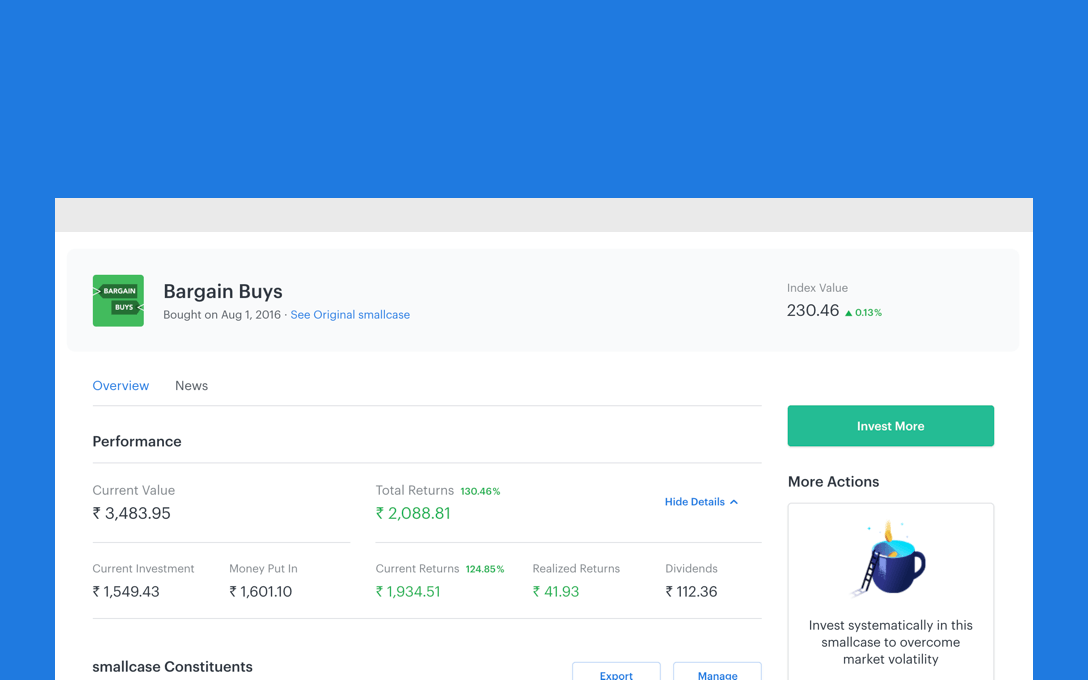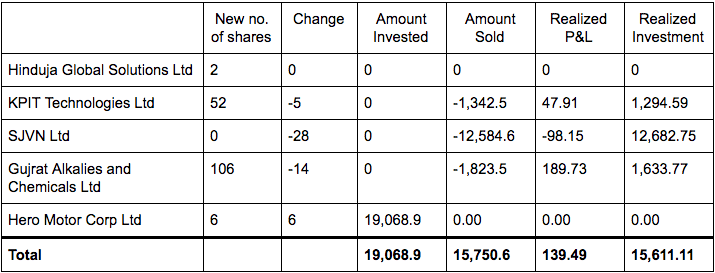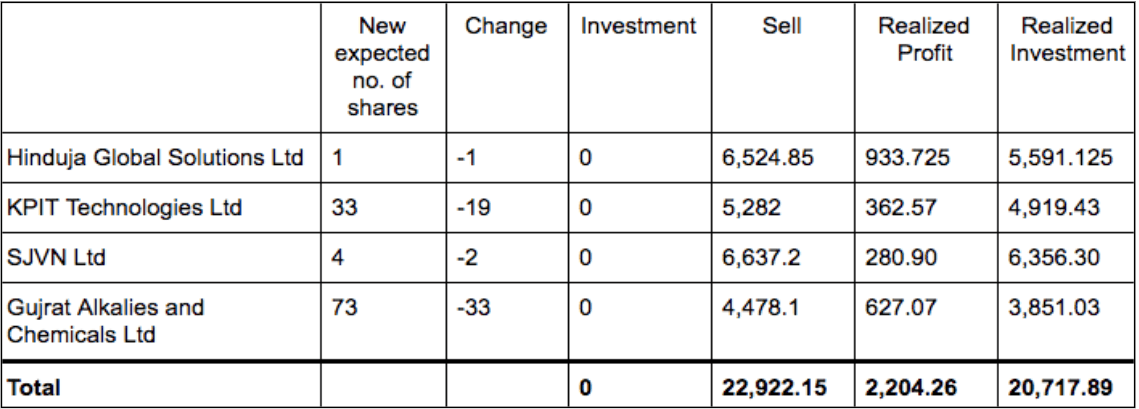smallcase Investments Details Explained

Taking a detailed look at the different numbers that are part of the investment overview for a particular smallcase.
Buying a smallcase
To track the performance of your smallcases, you need to come to your smallcase Investments page. Just click on the ‘Investments’ button on the top right of the navigation bar and you would be directed to the page. On this page you would be able to see and track returns generated by your smallcases, as well as the cumulative performance of all the smallcases
At the top of the page you can see the cumulative summary of all the smallcases


Just below this, all the smallcases bought by you are arranged in a reverse chronological order with the most recently bought smallcase at the top of the list. To view the investment details for a particular smallcase, click on the smallcase card from the Investments page.
Let’s see how the details section will look immediately after you buy this smallcase and understand all the terms in the Investment Overview section
Current Value
At any given point it represents the networth of the smallcase i.e. the amount you will receive, if you decide to sell the smallcase. It is the sum of current value of your holding in each of the stocks. For example, let’s say you bought 26 shares of KPIT and the current price of the stock is 241.65. Thus, value of your investment in KPIT is Rs 6282.9 (26*241.65). If you sum the current values for all the stocks, you will arrive at the current value of the smallcase
Current smallcase Investments
It represents the amount of money currently invested in the smallcase. It is the sum of the smallcase investments into each of the stocks. The value of the investment in a stock is average buy price multiplied by the number of shares. In our current example, average buy price of the stocks is the price at which they were bought, as there are no multiple transactions for every stock at different prices. So the current investment in KPIT would be 26*241.65 = Rs 6282.9. If you sum up the current investment values for all the stocks, you will get the Current Investment amount of the smallcase shown in the Investment Overview
Money Put In
It represents the amount of money that you have put in the smallcase. You must be wondering, how it is different from the Current Investment. Well, current investment is the amount of money currently invested, while Money Put In is the amount of money used to generate the returns that you see. It might be currently invested, or might not. The difference will become more clear, as we move ahead in the example
Current Returns
It is the amount of profit that you will make if you decide to sell the smallcase. It is calculated as the difference between Current Value and the Current smallcase Investments
Realized Returns
It represents the total profit/loss that you have already booked. Whenever you make a transaction that results in selling a few stocks from your smallcase, you will always be either booking some profit if the price of the stock has gone up since you bought the smallcase or booking some loss, in the opposite case
Total Returns
It is the sum of realized and current returns and shows how much money you have made using a particular smallcase. The % P&L is the Total returns divided by the money put in i.e. how much % return you have made on the total money used in the smallcase
Incase you are interested in watching a video to understand these concepts, check out the video below:
Now that we’ve gone over what the values under the investment overview section indicate, let’s understand how these values are impacted with the help of an example:
Investing More
Let’s say after 15 days of investing in this smallcase, you decide to check the performance. So you login and go to the smallcase investments page on 15th Feb’17. This is how your ‘Details’ section will look:

You can see that currently you are making a return of around 5%. And decide to invest more money into the smallcase using the invest more option. Let’s say you decide to invest Rs. 30,000 more into the smallcase and invest more page optimized the investment amount to Rs 28,665.35. Based on the current weighting scheme of the portfolio, the money that should go into each stock to maintain the scheme. And how many shares of each stock need to be bought for the same is allocated. After investing more, this is how your Investment Overview will look:

After the trade, your current investment increases. As explained, it represents the amount currently invested in the smallcase. Previously it was Rs 23961.7. You invested Rs 28665.35 more into the smallcase, hence the total current investment becomes Rs 52627.05. Current value also increases by the same amount, i.e Rs.28665.35
As you can see, the absolute current returns number doesn’t change because you just invested more and have not made any profit or loss on the same. However the total P&L% dropped, this is because it represents the P&L generated on the total money put into the smallcase. As the money put in increased, total P&L% came down. This is because you now have a lot of money invested on which you haven’t yet made any profit
Rebalance
Let’s say you receive an email from us on 1st of March that your smallcase has a rebalance update. To checkout the same, you login to the platform and before rebalancing the smallcase you check the details section. This is how you details section would look before rebalancing:

You notice that you are making a total profit of Rs 2731.25 – 5.19% of the money put in by you in the smallcase. You check out the rebalance update and it says that SJVN has been removed and Hero Motocorp has been added. To apply the changes you go the Manage section and click on Apply Update. To understand more about rebalancing, please check this link.
When you rebalance a smallcase, two things happen:
- Stocks which got removed from the smallcase are sold and stocks which got added are bought
- We try to move the weighting scheme as close as possible to the prescribed weighting scheme
The above changes are made while ensuring that the rebalance cost you incur is minimal. Let’s say the following happens during the rebalance, at the individual stock level:

In the above table, you can see that all 28 shares of SJVN were removed from the smallcase and 6 shares of Hero MotoCorp were bought. 5 shares of KPIT and 14 shares of Gujrat Alkalies were sold as well, to correct the weighting scheme
As explained earlier, whenever you sell shares, you either book profit or loss. If the price at which you are selling the stock is more than the average buying price, you book profit – as on an average, current price of each share is more than the price at which you bought it. Let’s look at the KPIT row and understand each of the element
In the rebalance you sold 5 shares of KPIT at the current price of 268.5. Amount sold = 268.5 * 5 = 1342.5. Also the selling price of 268.5 was more than the average buying price of KPIT – Rs 258.92. Thus, you booked profit equivalent to (268.5 – 258.92) * 5 = 47.91. It is simply the profit made on each share multiplied by the number of shares sold. The average buy price was 258.92. Thus your investment in the 5 shares of KPIT which you sold was Rs 1294.59 (258.92 * 5) and you have taken out this investment
In total, you booked a combined profit of Rs 139.49 on all the stocks and took out an investment of 15611.11. Note that if you add both the figures: 139.49 + 15611.11, you will get 15750 which the total selling amount. This makes sense as the total sell amount will be equal to your investment plus any profits or loss. As you can see the amount invested is Rs 3318.3 which is higher than the amount sold and will thus increase the total money put in by this amount. This is how the investment overview will look after the rebalance.

As you can see, the Money Put In increased by Rs 3318.3 which is the extra investment made by you in the trade. Another interesting thing to notice is that total P&L of Rs 2731.25 remained the same, before and after the rebalance. It’s just that you booked Rs 139.49 out of Rs 2731.25. Also, the total P&L % came down a little bit because you put an extra Rs 3318.3 on which you haven’t yet made any money (the same thing which happened after investing more)
Partial Exit
Let’s say we are in May now, and you need to draw some money out of smallcase for personal use. You login to smallcase and go to the details of your smallcase. This is how it will look on 1st of May’17:

You decide to use the Partial Exit feature to draw around Rs 23,000 from the smallcase. You can read more about the Partial Exit feature here. When you place the Partial Exit order for around Rs 23K, these trades are triggered:

As explained earlier in the case of rebalance, whenever you sell shares from your smallcase you either book profit or loss. When the sell price is more than the average buy price, you book profits and when it is less than the average buy price, you book loss. In the above Partial Exit case, we sold 1, 19, 2 and 33 shares of Hinduja, KPIT, Hero and Gujrat Alkalies, respectively. In each case, current price was more than the average buying price, thus you booked profits. To understand Realized Profit and Realized Investment in more detail, please read the above rebalance case.
The total amount sold was Rs 22,922.15, out of which Rs 20,717.89 was your investment and Rs 2,204.26 was the profit made on the investment. This is how the details section will look after Partial Exit trade is complete:

As you can see, the current smallcase investments drop by an amount of Rs 20717.89, as this is the investment taken out by you. Money Put In remains the same, as it represents the total money put in by you to generate the total P&L. Total P&L includes the Realized P&L which was generated using the money taken out. Thus Money Put In includes everything – amount current invested or previously invested. Again, you can see that the Total P&L remains same, it just gets redistributed between Realized and Current. Current P&L drops by Rs 2204.26 – the realized profit booked in the current trade and the realized P&L increase by the same amount.






